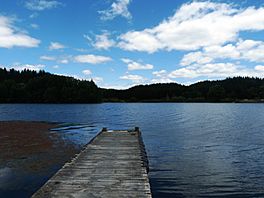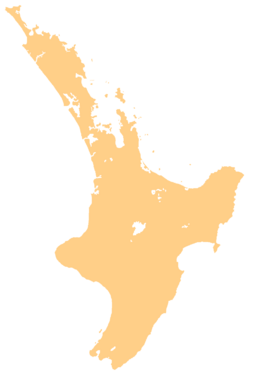Lake Āniwaniwa facts for kids
Quick facts for kids Lake Āniwaniwa |
|
|---|---|
| Lake Aniwhenua | |

View of Lake Āniwaniwa from the jetty
|
|
| Location | Bay of Plenty, North Island, New Zealand |
| Coordinates | 38°19′30″S 176°47′15″E / 38.32500°S 176.78750°E |
| Type | reservoir |
| Native name | Āniwaniwa Error {{native name checker}}: parameter value is malformed (help) |
| River sources | Rangitaiki River |
| Max. length | 4.5 km (2.8 mi) |
| Max. width | 0.5 km (0.31 mi) |
| Surface area | 2.1 km2 (0.81 sq mi) |
| Max. depth | 10 m (33 ft) |
Lake Āniwaniwa, also sometimes called Lake Aniwhenua, is a small lake in New Zealand. It's not natural; people made it on the Rangitaiki River in the Bay of Plenty region. You can find it about 13 kilometers (8 miles) north of Murupara town.
This lake was formed when a 10-meter (33-foot) tall dam was built. This dam helps power the Aniwhenua hydroelectric scheme, which makes electricity.
Contents
About Lake Āniwaniwa
Lake Āniwaniwa is long and not very deep. It stretches about 4.5 kilometers (2.8 miles) long and is about 0.5 kilometers (0.3 miles) wide. Its total area is around 2.1 square kilometers (0.8 square miles).
The Whakatane District Council looks after a campground on the lake's northeastern side. This is a great spot for people to visit and enjoy the lake.
How the Lake Was Made
Engineers studied the area in the 1970s to see if they could build a power station. Construction on the Aniwhenua hydroelectric scheme began in 1977 and finished in 1981. This project included building the 10-meter (33-foot) dam that created Lake Āniwaniwa.
The lake was first mistakenly called Lake Aniwhenua. This name came from the nearby Āniwaniwa falls. However, in 2012, under the Ngāti Manawa Claims Settlement Act 2012, the official name became Lake Āniwaniwa.
Animals and Plants of the Lake
Fish Species
Lake Āniwaniwa is home to different types of fish. You can find both longfin and shortfin eels here. These eels usually travel down the Rangitaiki River every autumn. Young eels, called elvers, also swim upstream.
However, the dams at Lake Āniwaniwa and Matahina have made it harder for eels to migrate. To help them, people started moving elvers upstream by hand in 1983. This work was continued by the Department of Conservation. By 1995, about 149,000 elvers were being moved to Lake Āniwaniwa each year. Some local people also help move eels to and from the lake.
Besides eels, the lake also has rainbow trout, brown trout, mosquitofish, common bully, and goldfish.
Birdlife Around the Lake
Many native waterbirds live at Lake Āniwaniwa. These include the New Zealand shoveler, New Zealand scaup, and Australian coot.
Surveys done in the 1980s, a few years after the dam was built, found other birds too. These were the marsh crake, spotless crake, New Zealand dabchick, and the Australasian bittern. The Australasian bittern is a threatened bird species.
Hunting and Fishing Activities
People are allowed to fish for trout in Lake Āniwaniwa. During the special hunting season, game birds can also be hunted here.
In 2003, there was some discussion when the Fish & Game Council allowed hunting at the north end of the lake. Some people worried it might be unsafe because of the nearby campground. However, Fish & Game explained that hunters must always be careful near public areas.


